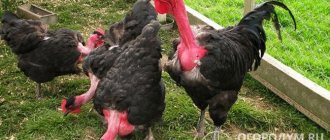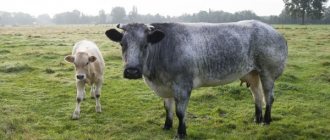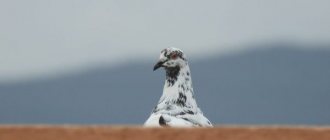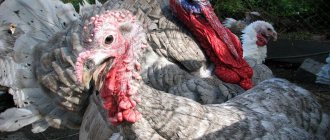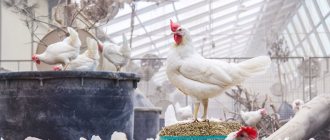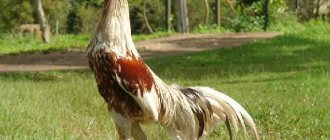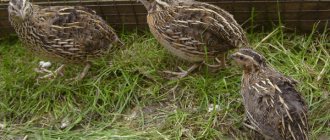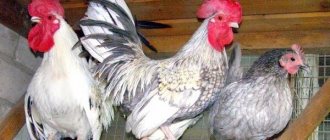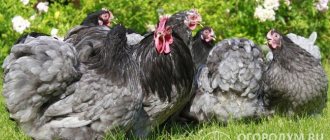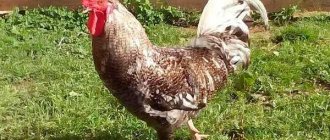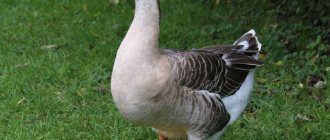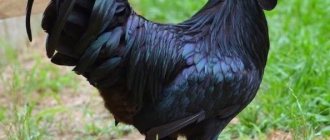Selected Isa Brown chickens were bred to increase the productivity of the original breeds. This is a hybrid chicken variety belonging to the egg type. Laying hens are characterized by high egg production and unpretentious maintenance. However, their appearance is similar to that of other crosses. A description of the external features, requirements for care and maintenance, and other characteristics of this cross are presented in the article.
How the new egg cross appeared
The Isa Brown broiler was first bred in Holland 3 decades ago, so it is considered a relatively young chicken variety.
Chickens of this subspecies were obtained by four-line crossing. This means that 4 genetic materials from domestic chicken breeds were used in the crossing.
The basis for breeding the cross was the Leghorn and Rhode Island. You can get acquainted with their features in the articles “About Leghorn chickens: characteristics of the breed” and “About the Rhode Island chicken breed.”
The new chickens were nicknamed Isa (or ISA), in honor of the Dutch scientific institute where they were obtained. The cross received the prefix “brown” for the brown color of its plumage.
Isa Brown laying hens are confused with Loman Brown hens, since the feather color of both representatives is brown. However, in the former, it is distributed unevenly throughout the body; white feathers are visible on the tail and wings.
You can find out about the competitor in the article “Breed of Loman Brown chickens.”
History of the origin of the breed
Isa Brown are egg-laying chickens bred by Dutch scientists. The selection used Italian Leghorns and Rhode Island meat and egg dogs of American origin. The new cross has proven itself well and, despite the fact that it is about 30 years old, has already managed to gain many fans in different countries.
Dutch chickens do not have an attractive appearance, but they can boast of high egg production, which they inherited from Leghorns. The unpretentiousness to feed and undemandingness to care and living conditions was transferred to laying hens from Rhode Island.
Characteristics of the Dutch cross
Exterior
The exterior of Isa Brown broilers does not have any outstanding features.
Representatives of the Isa Brown subspecies are small in size and have a light skeleton. Males are larger and weigh on average 2.8 kilograms, females weigh 1.9 kilograms.
Chickens have a small head with a leaf-shaped comb and red earrings. The beak is strong, slightly curved, pink in color with a light tint. The sternum protrudes forward, the neck is long and curved.
The back of Isa Brown chickens is straight. There is no feathering on the paws, and the skin is characterized by a yellow tint. The tail is short, raised upward. The eyes are dark and orange.
It is not difficult to distinguish an Isa Brown hen from a rooster even at a young age. Females have dark brown plumage, while males are characterized by light yellow and red tones. There is a significant difference in the weight category of birds.
Varieties of color
There are Isa Brown and white crosses, whose separate name is Isa White.
White chickens correspond to the description of the brown variety's appearance. The main difference is the snow-white plumage without splashes of other colors. Size and productivity are also identical.
Temperament
The character of Isa Brown and White laying hens is moderate and calm. Phlegmatic chickens get along well with their relatives, do not have conflicts, and do not get into fights.
Birds are completely free of aggression. These are mobile, active chickens, which must be kept in a spacious chicken coop.
Farmers prefer Isa chickens due to their unpretentiousness. Birds easily adapt to adverse weather conditions. They do not require large financial investments in care.
For these reasons, the cross is considered one of the most cost-effective.
Description of the cross
This hybrid does not have any distinctive external features. Moreover, it is very difficult to distinguish it from the same Highsex Brown and other brown layers.
The hybrid has a fairly folded, small body with light bones and a narrow back. The chest is convex, especially in roosters.
The comb is small, both in cockerels and hens, of a leaf type. Color red. The earrings are also red, but slightly different from the comb in their brightness.
The tail is small and raised up. The legs are yellow, without feathers, and of medium length. The beak is light gray in color and quite powerful. The wings fit very tightly to the bird's body.
Since this is a “Brown”, it is not difficult to guess that the color of the laying hens is almost completely brown.
Performance Metrics
The period of puberty in domestic brown and white chickens is 4.5–5 months. Despite their small size, laying hens break records for productivity. The Dutch hybrid rightfully belongs to the egg type.
In a year, chickens are capable of laying up to 320 eggs with a dense, dark shell, weighing up to 65–70 grams. Brown eggs are valued higher than white eggs and are in high demand for sale.
Isa brown and white reaches peak productivity in the first 2 years of life, then egg production decreases. For good productivity, one laying hen must receive at least 110 grams of feed per day.
Isa brown and white are classified as early ripening hybrids, since the period of active egg laying is 18–91 weeks. The period varies in the range +/- 2 weeks.
Productivity
Isa-Brown is a pure egg cross. It was created for this purpose. On average, Iza produces about 320 eggs per year, which is a fairly good indicator. The eggs of this cross are quite large in size. On average, an egg weighs about 60 grams. There may also be specimens weighing 70 grams.
The shell is quite strong and brown in color. Thanks to this, eggs can be easily transported over long distances, which is a big plus in commercial production.
If we talk about the quality of meat, it is quite bad. The meat of this cross is very tough and is only suitable for broth. At industrial enterprises, “spent” laying hens are processed into animal feed.
How to properly feed hybrid chickens
Feed Conversion Rates
Adult roosters of the Isa subspecies weigh on average a kilogram to one and a half more than chickens.
To increase the productivity of chickens, their diet must be balanced. In addition, proper feeding increases the number of eggs in the clutch and the strength of the shell.
It is recommended to prepare chicken feed from the following ingredients:
- bone meal;
- fish oil;
- oatmeal;
- bran;
- grains;
- potatoes and other root vegetables;
- fresh herbs;
- legume seeds.
Laying hens are fed three times a day: morning, afternoon and evening.
It is important to add calcium and protein to the feed. If independent preparation of feed is not possible, chickens are fed with specialized feed. Feed conversion is 2.14 kg/kg.
Features of feeding at peak egg production
Brown and white laying hens have a specific metabolism. Therefore, the lack of minerals and vitamins in the diet of chickens provokes thinning and fragility of the eggshell.
The content of calcium, B vitamins and fiber should cover the daily requirement of eggs. Especially during peak egg production. Grains should make up 50% of the diet, vitamin and mineral elements - at least 30%.
To simplify the feeding process, poultry farms use balanced combined feeds.
Incubation
The breed hatches well in an incubator and does not require special conditions. It is enough to ensure standard optimal conditions of temperature and humidity and turn the eggs regularly.
Table of temperature and humidity modes
| Period |
